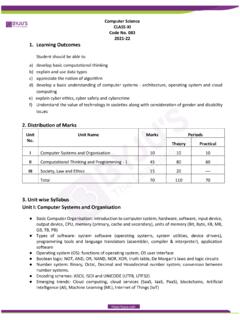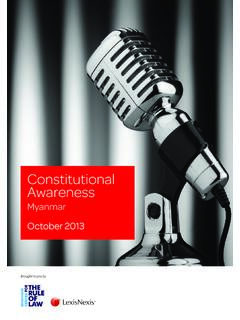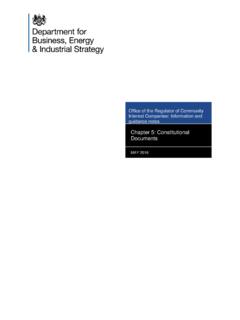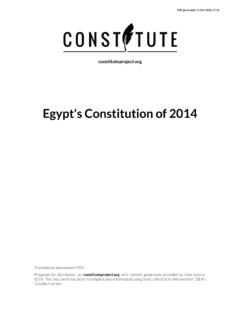Transcription of Panchayati Raj - 73rd Constitutional Amendment Act
1 Panchayati Raj - 73rd Constitutional Amendment Act A three-tier structure of the Indian administration for rural development is called Panchayati Raj. The aim of the Panchayati Raj is to develop local self-governments in districts, zones, and villages. Panchayati Raj is an important topic and questions are often asked from this section for the IAS exam. This article will provide you with evolution, various committees set-up for Panchayati Raj, salient features of the 73rd Constitutional Amendment Act, functions of Gram Panchayat, and other details regarding this topic for the polity and governance segment of the UPSC syllabus. Introduction to Panchayati Raj Rural development is one of the main objectives of Panchayati Raj and this has been established in all states of India except Nagaland, Meghalaya and Mizoram, in all Union Territories except Delhi.
2 And certain other areas. These areas include: a. The scheduled areas and the tribal areas in the states b. The hill area of Manipur for which a district council exists and c. Darjeeling district of West Bengal for which Darjeeling Gorkha Hill Council exists Evolution of Panchayati Raj The Panchayati system in India is not purely a post-independence phenomenon. In fact, the dominant political institution in rural India has been the village panchayat for centuries. In ancient India, panchayats were usually elected councils with executive and judicial powers. Foreign domination, especially Mughal and British, and the natural and forced socio-economic changes had undermined the importance of the village panchayats. In the pre-independence period, however, the panchayats were instruments for the dominance of the upper castes over the rest of the village which furthered the divide based on either the socio-economic status or the caste hierarchy.
3 The evolution of the Panchayati Raj System, however, got a fillip after the attainment of independence after the drafting of the Constitution. The Constitution of India in Article 40 enjoined: "The state shall take steps to organise village panchayats and endow them with such powers and authority as may be necessary to enable them to function as units of self-government". There were a number of committees appointed by the government of India to study the implementation of self-government at the rural level and also recommend steps in achieving this goal. The committees appointed are as follows: Balwant Rai Mehta Committee Ashok Mehta Committee G V K Rao Committee L M Singhvi Committee Balwant Rai Mehta Committee & Panchayati Raj The committee was appointed in 1957, to examine and suggest measures for better working of the Community Development Programme and the National Extension Service.
4 The committee suggested the establishment of a democratic decentralised local government which came to be known as the Panchayati Raj. Recommendations by the Committee: Three-tier Panchayati Raj system: Gram Panchayat, Panchayat Samiti and Zila Parishad. Directly elected representatives to constitute the gram panchayat and indirectly elected representatives to constitute the Panchayat Samiti and Zila Parishad. Planning and development are the primary objectives of the Panchayati Raj system. Panchayat Samiti should be the executive body and Zila Parishad will act as the advisory and supervisory body. District Collector to be made the chairman of the Zila Parishad. It also requested for provisioning resources so as to help them discharge their duties and responsibilities. The Balwant Rai Mehta Committee further revitalised the development of panchayats in the country, the report recommended that the Panchayati raj institutions can play a substantial role in community development programmes throughout the country.
5 The objective of the Panchayats thus was the democratic decentralisation through the effective participation of locals with the help of well-planned programmes. Even the then Prime Minister of India, Pandit Jawaharlal Nehru, defended the panchayat system by saying, ".. authority and power must be given to the people in the villages .. Let us give power to the panchayats." Ashok Mehta Committee & Panchayati Raj The committee was appointed in 1977 to suggest measures to revive and strengthen the declining Panchayati Raj system in India. The key recommendations are: The three-tier system should be replaced with a two-tier system: Zila Parishad (district level) and the Mandal Panchayat (a group of villages). District level as the first level of supervision after the state level. Zila Parishad should be the executive body and responsible for planning at the district level.
6 The institutions (Zila Parishad and the Mandal Panchayat) to have compulsory taxation powers to mobilise their own financial resources. G V K Rao Committee & Panchayati Raj The committee was appointed by the planning commission in 1985. It recognised that development was not seen at the grassroots level due to bureaucratisation resulting in Panchayat Raj institutions being addressed as grass without roots . Hence it made some key recommendations which are as follows: Zila Parishad to be the most important body in the scheme of democratic decentralisation. Zila Parishad to be the principal body to manage the developmental programmes at the district level. The district and the lower levels of the Panchayati Raj system to be assigned with specific planning, implementation and monitoring of the rural developmental programmes. Post of District Development Commissioner to be created.
7 He will be the chief executive officer of the Zila Parishad. Elections to the levels of Panchayati Raj systems should be held regularly. L M Singhvi Committee & Panchayati Raj The committee was appointed by the Government of India in 1986 with the main objective to recommend steps to revitalise the Panchayati Raj systems for democracy and development. The following recommendations were made by the committee: The committee recommended that the Panchayati Raj systems should be constitutionally recognised. It also recommended Constitutional provisions to recognise free and fair elections for the Panchayati Raj systems. The committee recommended reorganisation of villages to make the gram panchayat more viable. It recommended that village panchayats should have more finances for their activities. Judicial tribunals to be set up in each state to adjudicate matters relating to the elections to the Panchayati Raj institutions and other matters relating to their functioning.
8 All these things further the argument that panchayats can be very effective in identifying and solving local problems, involve the people in the villages in the developmental activities, improve the communication between different levels at which politics operates, develop leadership skills and in short help the basic development in the states without making too many structural changes. Rajasthan and Andhra Pradesh were the first to adopt Panchayati raj in 1959, other states followed them later. Though there are variations among states, there are some features that are common. In most of the states, for example, a three-tier structure including panchayats at the village level, panchayat samitis at the block level and the zila parishads at the district level-has been institutionalized. Due to the sustained effort of the civil society organisations, intellectuals and progressive political leaders, the Parliament passed two amendments to the Constitution - the 73rd Constitution Amendment for rural local bodies (panchayats) and the 74th Constitution Amendment for urban local bodies (municipalities) making them 'institutions of self-government'.
9 Within a year all the states passed their own acts in conformity to the amended Constitutional provisions. 73rd Constitutional Amendment Act of 1992 Significance of the Act The Act added Part IX to the Constitution, The Panchayats and also added the Eleventh Schedule which consists of the 29 functional items of the panchayats. Part IX of the Constitution contains Article 243 to Article 243 O. The Amendment Act provides shape to Article 40 of the Constitution, (directive principles of state policy), which directs the state to organise the village panchayats and provide them powers and authority so that they can function as self-government. With the Act, Panchayati Raj systems come under the purview of the justiciable part of the Constitution and mandates states to adopt the system. Further, the election process in the Panchayati Raj institutions will be held independent of the state government's will.
10 The Act has two parts: compulsory and voluntary. Compulsory provisions must be added to state laws, which includes the creation of the new Panchayati Raj systems. Voluntary provisions, on the other hand, is the discretion of the state government. The Act is a very significant step in creating democratic institutions at the grassroots level in the country. The Act has transformed the representative democracy into participatory democracy. Salient Features of the Act 1. Gram Sabha: Gram Sabha is the primary body of the Panchayati Raj system. It is a village assembly consisting of all the registered voters within the area of the panchayat. It will exercise powers and perform such functions as determined by the state legislature. Candidates can refer to the functions of gram panchayat and gram panchayat work, on the government official website - 2.
















